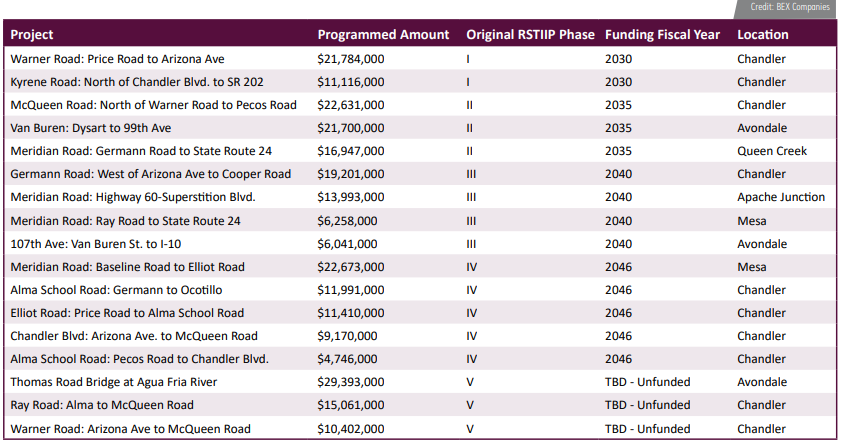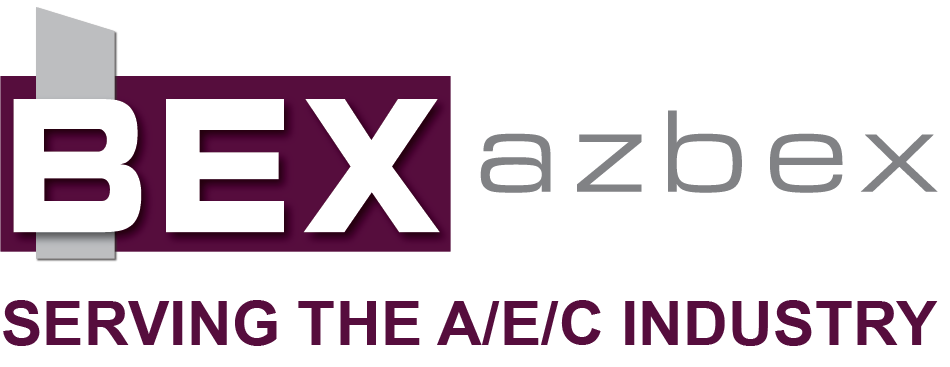By Roland Murphy for AZBEX

With implementation of the Maricopa County Proposition 479 half-cent transportation sales tax set to begin at the start of next year, carrying on the previous funding from the expiring Proposition 400, the Maricopa Association of Governments is working to finalize its Arterial Life Cycle Program.
The ALCP is a reimbursement-based program funded entirely by Prop 479 revenues. Policies for the program were developed by MAG’s ALCP Working Group and approved by the MAG Regional Council in March.
Programming for the ALCP is spread across five phases, covering, and even looking beyond, Prop 479’s 20-year lifespan. The phasing breaks down as:
- Phase I: 2026-2030; $32.9M programmed;
- Phase II: 2031-2035; $61.3M programmed;
- Phase III: 2036-2040; $45.5M programmed;
- Phase IV: 2041-2046; $60M programmed, and
- Phase V: 2047 onward; $54.9M programmed but unfunded.
The 14 projects across all four phases programmed and funded over the course of Prop 479’s 20-year lifecycle total nearly $199.7M.
Prop 479 ALCP Considerations
MAG, its member agencies, their supporters and other transportation advocates faced a hard fight to even get the measure on the ballot for voter consideration and approval.
In July 2022, former Gov. Doug Ducey vetoed enabling legislation for the ballot measure that had been passed by the Arizona Legislature and endorsed by all 32 of MAG’s member jurisdictions. While Ducey’s overall reasoning remains a matter of speculation, his stated reasons at the time concerned the originally proposed 25-year timeline (rather than the 20 years under the preceding program), reduction and lack of clarity on freeway funding, and a stated failure to account for other funding sources, including the Infrastructure Investment and Jobs Act.
AZBEX covered the issue more extensively than any other news outlet. Our full set of articles and columns is available here.
When the next legislative session finally passed a significantly altered bill, roads and streets became the primary focus under the enabling legislation. A key consideration under the law is costs for the arterial program cannot exceed available revenues over the tax’s 20-year lifespan.
Estimates for the program were originally generated in the fall of 2020, and reimbursement amounts were originally expressed in 2020 constant dollars in the approved Regional Strategic Transportation Infrastructure Investment Plan.
The draft Fiscal Year 2026 Prop 479 ALCP currently under consideration has had the reimbursements inflated to be expressed in 2026 constant dollars, according to materials presented to MAG’s Transportation Review Committee in May.
The program allows for advancements and deferments. Member agencies can swap projects on a one-for-one basis without committee action using the process established under the policies and procedures.
A separate project change tool has also been established to allow bringing a new project in exchange for an existing one. That process will require committee action and will use evaluative tools to score the project using both qualitative and quantitative criteria.
Program Development Timeline
In January of this year, MAG updated the ALCP program and policy development. This was followed in February by various agency meetings to discuss ALCP projects and development of the project book with all projects in the last year of phase.
The Regional Council approved the policies and procedures for the program in March.
Throughout March and April, MAG continued coordination with its member agencies for ALCP development, and the program advanced through the Association’s committees in May.
Approval of the FY 2026 Prop 479 ALCP is expected June 30.
The table below breaks out the 17 projects currently included in the ALCP by their original RSTIIP Phases and includes their programmed funding.

We hope you have enjoyed the last few issues covering Prop 479 planning and have gotten a useful overview of the upcoming freeway and street projects. We will continue to keep an eye on events as they evolve.

